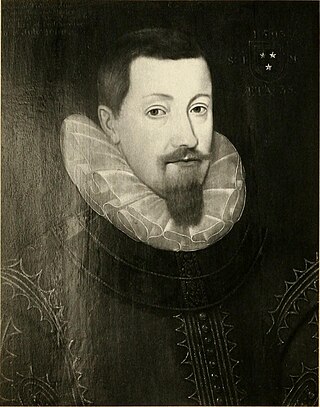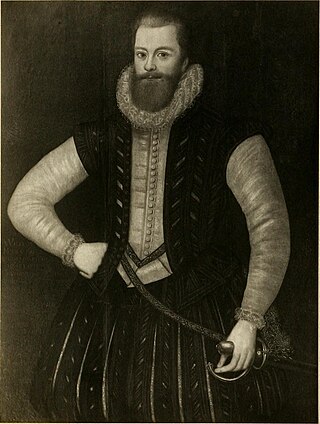Related Research Articles
John Stewart, 4th Earl of Atholl, called the Fair, was a Scottish nobleman and courtier. He was favoured by Mary, Queen of Scots, but later turned against her.

Francis Hay, 9th Earl of Erroll was a Scottish nobleman. A convert to Catholicism, he openly conspired with the king of Spain to try to unseat the Protestant Queen Elizabeth.
William Ruthven, 1st Earl of Gowrie, 4th Lord of Ruthven was a Scottish peer known for devising the Raid of Ruthven.
Lord Innermeath is an extinct title in the Peerage of Scotland created c. 1471 for Walter Stewart, 1st Lord Innermeath. Stewart had previously been Lord of Lorne, but resigned that title - which came with substantial comital power - under pressure from James III; James wished to weaken the remaining power of the Black Douglases, who had been allies of Walter's uncle, The Black Knight of Lorn. Walter had in fact held the Lordship of Lorne for only a few days, following the murder of his brother, the former Lord of Lorne.
John Stewart, 2nd Earl of Atholl was the second Earl of Atholl. He fought in the Battle of Flodden on 9 September 1513.
David Lindsay, 9th Earl of Crawford was a Scottish peer and Member of Parliament.
Sir Thomas Lyon, Master of Glamis was a Scottish nobleman and official, Lord High Treasurer of Scotland.
David Lindsay, 11th Earl of Crawford (1547?–1607) was a Scottish nobleman and privy councilor.

John Murray, 1st Earl of Tullibardine was a Scottish courtier and leader of the Clan Murray.
John Stewart, 5th Earl of Atholl, (1563–1595) was a Scottish landowner.
James Lindsay, 7th Lord Lindsay PC, Scottish landowner who was a gentleman of King James's bedchamber.
John Stewart, 1st Earl of Atholl (1566-1603) was a Scottish landowner.

William Murray, 2nd Earl of Tullibardine was a Scottish landowner and courtier.
Elizabeth Stewart, Countess of Arran was a Scottish aristocrat and political intriguer. Several accounts of her actions and ambition were written by her political enemies.
Patrick Drummond, 3rd Lord Drummond (1550–1600) was a Scottish landowner.
Margaret Douglas, Countess of Bothwell was a Scottish aristocrat and courtier.
Katherine Campbell, Countess of Crawford born Katherine Campbell was a Scottish noblewoman. She married twice and controlled a substantial inheritance.
Marie Ruthven, Countess of Atholl, was a Scottish aristocrat.

Dorothea Stewart, Countess of Gowrie was a Scottish aristocrat. The dates of the birth and death of Dorothea Stewart are unknown.
Janet Stewart was a Scottish aristocrat.
References
- ↑ David Masson, Register of the Privy Council of Scotland: 1578-1585, vol. 3 (Edinburgh, 1880), p. 491.
- ↑ Balfour Paul, Sir James. The Scots Peerage: founded on Wood's ed. of Sir Robert Douglas's Peerage of Scotland; containing an historical and genealogical account of the nobility of that kingdom, vol. 5 (Edinburgh, 1904), pp. 1-8
- ↑ Calendar State Papers Scotland: 1589-1593, vol. 10 (Edinburgh, 1936), pp. 654, 657.
- ↑ Annie I. Cameron, Calendar State Papers Scotland: 1593-1595, vol. 11 (Edinburgh, 1936), p. 74.